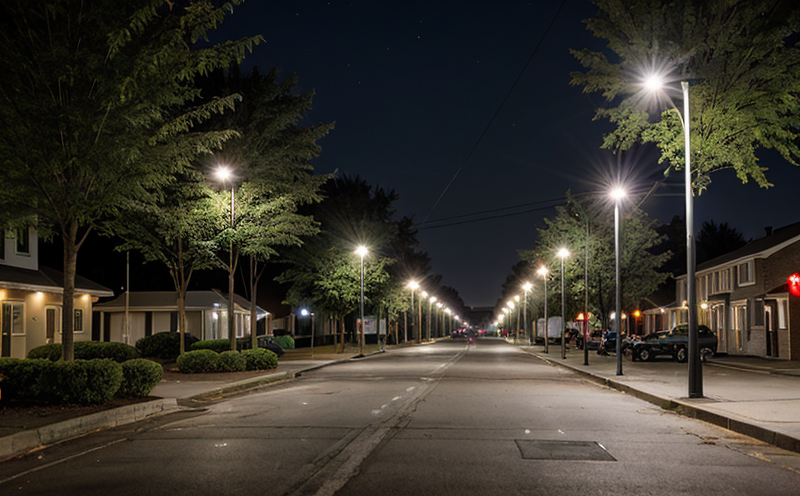CIE 189 Outdoor Lighting Testing of LED Packages and Systems
The CIE 189 standard provides a comprehensive approach to the testing of outdoor lighting systems, particularly focusing on LED packages and their integration into various applications. This international standard ensures that lighting fixtures meet stringent performance criteria related to luminous flux, color rendering index (CRI), light distribution, and other critical parameters under real-world conditions.
The process begins with careful preparation of the test specimens, which include both individual LED packages and complete outdoor lighting systems. The specimens are subjected to a series of environmental stress tests designed to mimic actual operating conditions, such as temperature cycling, humidity exposure, and mechanical stress. This ensures that the tested LEDs can withstand the rigors of outdoor use.
Key aspects of the testing include:
- Luminous Flux Measurement: Accurate measurement of luminous flux is crucial for assessing the light output performance of LED packages and systems. This involves precise calibration of photometers and integrating spheres to ensure reliable results.
- Color Rendering Index (CRI): Evaluating color rendering capabilities ensures that the lighting system accurately reproduces colors under outdoor conditions, which is essential for applications like roadways, parking lots, and commercial buildings.
- Light Distribution: The standard specifies detailed requirements for light distribution patterns to ensure uniform illumination over the intended area. This includes testing at various angles to assess how well the lighting system distributes light in all directions.
- Thermal Performance: Outdoor LED systems operate under challenging thermal conditions, and CIE 189 mandates thorough thermal stress testing to guarantee stable performance even when exposed to extreme temperatures.
The testing process is meticulous, involving advanced instrumentation and sophisticated software for accurate data collection and analysis. The use of high-precision instruments ensures that the results are reliable and repeatable, providing quality assurance for manufacturers and suppliers.
Compliance with CIE 189 not only enhances product reliability but also contributes to energy efficiency and environmental sustainability by promoting the development of high-performance LED lighting systems.
Applied Standards
| Standard | Description |
|---|---|
| CIE 189-2017 | This standard defines the requirements for evaluating the performance of outdoor lighting systems, including LED packages and complete fixtures. |
| IEC 62389-2015 | International Electrotechnical Commission standard that complements CIE 189 by providing additional guidelines on the measurement and evaluation of luminous flux in outdoor lighting systems. |
| ASTM E2471-2020 | American Society for Testing and Materials standard focusing on the environmental testing of LED light sources, which aligns with CIE 189 by ensuring robust performance under varying weather conditions. |
Competitive Advantage and Market Impact
CIE 189 compliance offers significant advantages for manufacturers and suppliers of outdoor lighting systems. By meeting this standard, companies demonstrate their commitment to producing high-quality LED packages and complete systems that are reliable and perform well under real-world conditions.
Compliance with CIE 189 enhances market credibility and trust among consumers and stakeholders. It ensures that the products meet international standards for performance, reliability, and sustainability. This can lead to increased sales and a stronger brand reputation in competitive markets.
In addition, adherence to this standard fosters innovation within the industry by encouraging the development of more efficient and effective lighting solutions. Manufacturers who comply with CIE 189 are better positioned to meet evolving regulatory requirements and customer expectations, thus gaining a competitive edge in the global market.
Use Cases and Application Examples
CIE 189 is particularly relevant for lighting applications where performance under outdoor conditions is critical. Some key use cases include:
- Roadways and Highways: Ensuring consistent illumination and color rendering over long distances.
- Parking Lots and Parking Garages: Providing adequate lighting for safe vehicle entry and exit, with accurate color reproduction for nighttime operations.
- Commercial Buildings: Enhancing the aesthetic appeal of buildings while ensuring safety and comfort for occupants.
- Public Spaces: Improving visibility in parks, plazas, and other public areas to enhance user experience and security.
By testing LED packages and systems against CIE 189 standards, manufacturers can ensure that their products meet the stringent requirements of these applications, thereby enhancing customer satisfaction and market competitiveness.





